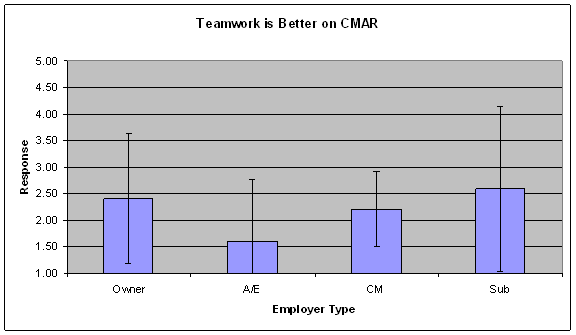
Partnering, Socialization, and Meetings
Teamwork improves with CMAR experience. Partnering, socialization, and frequent meetings are beneficial to teamwork.
Summary
Teamwork is better on CMAR than DBB (design-bid-build), and this teamwork improves with the parties’ CMAR experience. Formal partnering and informal socializing are useful. A minority, however, do feel that these are a waste of time. This opinion diminishes with increased CMAR experience. There is strong agreement that frequent meetings are useful.
Report
We all agree “teamwork” is a good thing – working together on a common goal. However research and common sense indicate that forming a team take time. There is a progression from “a collection of individuals” to a “high performing team.” The time required for this transition is acute for public construction projects, where a new team must be developed for each project. Teamwork is more of an issue for CMAR projects, where there must be good communications and trust between the parties from the start, than for DBB where teamwork is a social lubricant, but ultimately may not affect the parties’ actions very much.
Since we want to promote teamwork, we looked at two concepts that are reputed to help, “partnering” and “socialization.” But first we explored the whether or not teamwork is better on CMAR projects than DBB. We asked the respondents , “From my perspective, regarding governmental projects, teamwork is much better on CMR contracts than design-bid-build.” Score 1-5, where 1 means strongly agree and 5 means strongly disagree. And a follow-on question, “From my perspective, regarding governmental projects, teamwork improves with the number of CMR projects the team members have completed.” Here is the response to the first question:

The respondents felt that teamwork was better in CMAR, the overall average being 2.1. The chart indicates that A/Es agreed more, while Owners agreed less, and Subs agreed least. (There was no trend with respect to CMAR experience.) Note the large variance in the Subs’ responses. If Subs are bidding the work competitively and are not active in preconstruction, they may see no difference between CMAR and DBB. It is interesting that A/Es have the highest opinion of teamwork, since the A/E is most likely to have a negative economic impact from the CMAR process if there are many changes to the design. This may be because in DBB the contacts between contractors and A/E are not frequent, but what contacts there are may be stressful. In CMAR, the A/E and the contractors meet more often and on (presumably) a more cooperative basis. Another important concept is that reactions might vary with project phase. If design errors or worksite problems start to eat up the CM’s or Owner’s contingency, the parties are likely to become defensive.
The overall response to the second statement was 2.04, indicating agreement, and there were no significant differences by employer. There was a significant trend; that is, with more CMAR experience, there was more agreement with that concept.
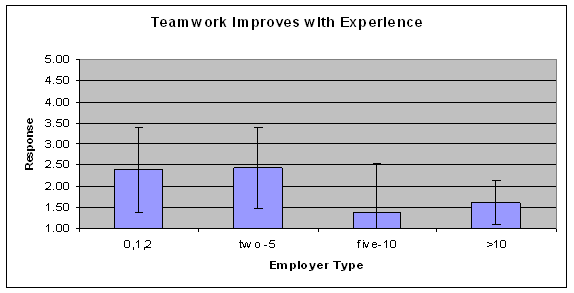
Of course, those with only a few CMAR projects would not have a large base with which to compare teamwork improvements, but teams are usually different for each project. For example, an Owner’s rep inexperienced with CMAR might be on a team with an A/E with extensive CMAR experience. Thus one with less experience might recognize improvement. In any case, the data supports improving teamwork with experience, or at least the belief that it improves.
Two respondents bring up good points: First, regarding a CM’s background, one with a design-build or negotiated construction background will adjust quickly. One with public DBB experience will need more time to adjust. Second, once CMs have made the adjustment, they probably will not get much better with time. Overall, however, there is agreement that teamwork improves the project. Also, while a CMs' transition from DBB to CMAR is somewhat predictable, if they are to be successful in that type of contracting, the transitions of the A/E and Owner are a less predictable but vital part of teaming. If Subs are bid, their relationship to the other parties may require less of a transition.
So can “partnering” improve or accelerate the transition to a “team?” We define in the survey a “formal” partnering, as meaning that with an outside facilitator and typically lasting a day or more.
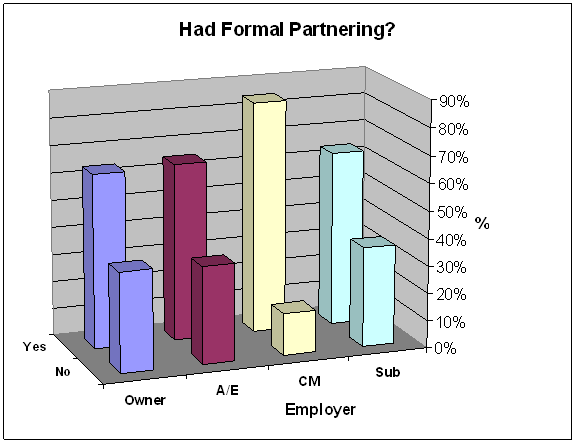
Overall, almost 70% of the respondents had some formal partnering training.
Next we wanted to determine if the respondents felt partnering was beneficial. (We tried to account for burnout in later questions.) We asked for response to this statement: “In general, for a major project (CMR or non-CMR), a formal partnering session is worth the time and expense.” Score 1-5, where 1 means strongly agree and 5 means strongly disagree. While employer results are not statistically significant, there is a trend that A/Es agree more, while Owners agree less (they pay for it). Based on CMAR experience, there was a clear trend that those with greater than 10 projects thought partnering was worth it. We next evaluated the response by including only those who had participated in partnering. When only the responses of those with formal partnering experience are counted, there is a clear and statistically significant trend indicating that those with more experience agree more. By employer, there was no significant difference, but again there was a trend, with A/Es believing it was worth it, while Owners believe less so.
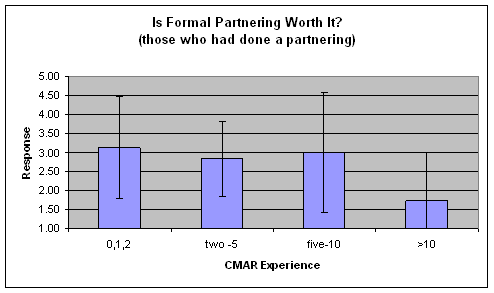
Note that those with more experience have probably sat through more sessions as well, but the trend indicates they have not burned out. Perhaps the following comment explains some of the variance in the responses: “It depends on the objectives, the facilitator, and the process utilized.”
With responses to the next two statements, we tried to sort out if some of those who thought partnering was not worth it felt that way because they were burned out from too many sessions. The first statement read, “Do you believe that formal partnering for your first or second CMR project was/would have been helpful? (Leave blank if you have not done a partnering.)” We found, overall, that there was a trend for A/Es to agree that partnering would be helpful, but Owners were neutral. Again, there was a trend indicating that those with more than 10 CMAR projects agreed that partnering would be helpful. With the second statement, we used a non-numerical format specifically to find out if “waste of time” increased with more projects: “Do you believe formal partnering for your later CMR projects, after the first two, would have been helpful?
Check/X one
___ I’m still on first or second,
___ Should have significant partnering for all major projects
___ Somewhat less important for me, but may be good for others in the project
___ Waste of time.
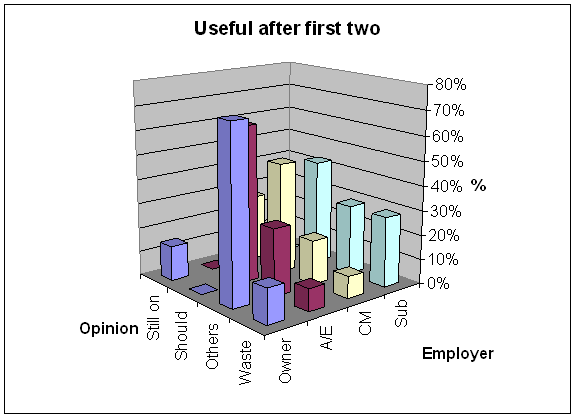
We see that almost 30% of subs feel it would be a waste of time, but almost 70% of subs feel it would be useful.
If we combine “Should have significant partnering for all major projects” and “Somewhat less important for me, but may be good for others in the project,” which are both favorable to partnering, and contrast that response with those for “Waste of time,” we see a distinct decrease with increasing CMAR experience perceiving a value in partnering, even if they have had partnering before.
|
Should plus Others |
Waste of Time |
New to CMAR |
33% |
17% |
Two to Five |
88% |
12% |
Five to Ten |
100% |
0% |
More than Ten |
92% |
8% |
Thus with increasing CMAR experience, there is an increasing positive reaction to partnering for later projects and a decreasing negative reaction.
Remember, the Owner usually pays for the partnering, and thus is more likely to perceive something as a waste if benefit is not derived. The Owners, however, were generally neutral on this question. The fact that those with more CMAR experience favored partnering does not support the concept of burn-out with more partnering.
An alternative to formal partnering would be socializations. We asked, “Do you feel meeting/socialization of all major project participants early in the project – a meeting/socialization less formal partnering but more than routine progress meeting, for example, a picnic or catered lunch, is a benefit to the project?
___ No real benefit/probably a waste of time,
___ Perhaps some benefit,
___ Probably beneficial,
___ Good idea/I’d recommend it.”
If we take out the second answer “perhaps” (which was probably not a good question; too vague) and combined the last two “probably beneficial” and “good idea,” we find, overall, that 60% felt that socialization was probably beneficial or would recommend it, while only 10% felt it was a waste. When we look at the employer category, however, we note Owners were skeptical—only 45% would recommend and almost 20% felt it was a waste. Based on length of CMAR experience (those with 5 to more than 10 projects), none felt it was a waste.
|
|
|
|
Probably + Good |
Waste of Time |
Owner |
45% |
18% |
A/E |
59% |
6% |
CM |
67% |
8% |
Sub |
67% |
8% |
|
Probably + Good |
Waste of Time |
New to CMAR |
71% |
14% |
Two to Five |
47% |
18 |
Five to Ten |
43% |
0% |
More than Ten |
71% |
0% |
While those who have done formal partnering are generally favorable to the value of partnering—and this increases with number of CMAR projects—there is some strong sentiment, albeit among a minority, that it is a waste of time. Generally, there are more Owners who disfavor partnering, but of course, they are the party that pays for it. Regarding the value of partnering after the first, Subs are more likely to feel it is a waste of time. An explanation for that is that a Sub’s managers may supervise more projects and, hence, be drawn into more partnering sessions, becoming burned out on them.
Several respondents commented that partnering should begin early in the project, before stress regarding scope and budget start. Most subcontractors, however, are not identified until later in the projects; hence a timely partnering will be missing certain key players. Finally, some respondents commented that partnering is unlikely to change some people, as partnering is no substitute for integrity and a “good attitude” on the part of team members.
We asked about the frequency of meetings. While respondents noted that this would vary with the size and complexity of a project, there was overwhelming agreement that during preconstruction there should be frequent meetings. Eighty-three percent of respondents felt there should be a meeting each week or every two weeks. One issue that came up was the invitation of “users” to meetings. Several respondents expressed that users should only attend meetings at the end of the major design phases